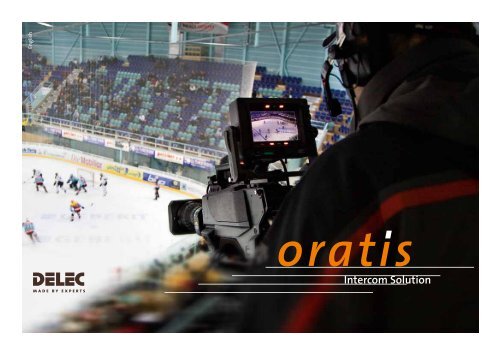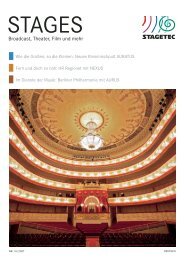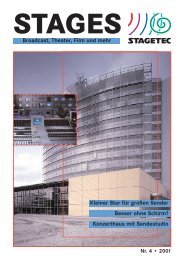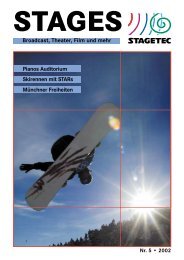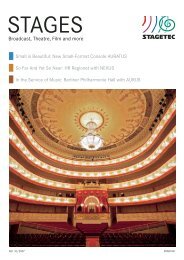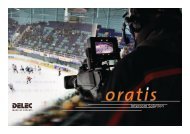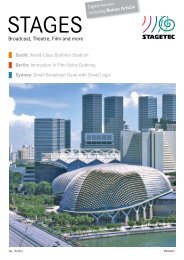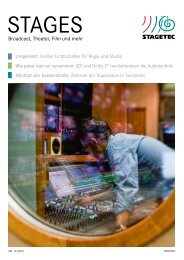DELEC oratis Intercom Solution - DELEC Audio
DELEC oratis Intercom Solution - DELEC Audio
DELEC oratis Intercom Solution - DELEC Audio
You also want an ePaper? Increase the reach of your titles
YUMPU automatically turns print PDFs into web optimized ePapers that Google loves.
English<br />
m a d e b y e x p e r t s<br />
<strong>Intercom</strong> <strong>Solution</strong>
02<br />
First For:<br />
Reliable <strong>Intercom</strong><br />
From simple to sophisticated<br />
The <strong>oratis</strong> is a first-class intercom system. It is based on<br />
current FPGA technology and offers unique flexibility and<br />
future-proofing combined with <strong>DELEC</strong>’s renowned high<br />
reliability.<br />
<strong>oratis</strong> can be used to create compact intercom systems<br />
featuring as few as eight ports to larger installations with<br />
more than 4,000 ports accessible simultaneously. The system<br />
employs the principle of distributed intelligence. This<br />
guarantees fast response times even on large systems, while<br />
ensuring confidence and security. <strong>oratis</strong> acts as a fully<br />
summing digital audio matrix.<br />
The benefits:<br />
Leading technology, safe investment<br />
Space-saving I/O with the highest density<br />
Open, scalable configuration<br />
Perfect audio quality 48kHz / 24bit<br />
Innovative subscriber panel design<br />
Convenient set-up<br />
Excellent reliability with flexible redundancy<br />
No single point of failure<br />
Networked via Ethernet cabling<br />
Adaptable and Scalable<br />
<strong>oratis</strong> intercom systems include at least three basic components:<br />
one or more matrix frames, various matrix cards, and the<br />
subscriber panels connected to them.<br />
The quantity and configuration of components are freely<br />
definable, enabling the <strong>oratis</strong> to adapt to a multitude of<br />
applications.<br />
To increase the number of matrix points, just add more matrix<br />
cards. <strong>oratis</strong> scales up from small systems to campus or even<br />
region wide installations with centralised intercom routers and<br />
comprehensive logical functions.<br />
Each matrix card acts as a self-contained, independent audio<br />
router. Thanks to the unique concept of distributed<br />
intelligence, the <strong>oratis</strong> avoids any single point of failure –<br />
maximum reliability and security are built into the foundations<br />
of the system!<br />
Matrix Frame Matrix Card Subscriber Panel<br />
03
04<br />
Keeping Your Connections in View:<br />
User-friendly Subscriber panels<br />
<strong>oratis</strong> subscriber panels are offered in two versions<br />
which both indicate the call destinations with up to<br />
18 characters of full text in every major language. The<br />
subscriber panels equipped with extra-large LCD<br />
buttons offer superior convenience and are also<br />
furnished with a rotary encoder per button for fast<br />
access to crosspoint volume adjustment. However, the<br />
compact subscriber units with one large display and<br />
smaller keys can provide higher packing density. Both<br />
display versions guarantee optimum legibility in all<br />
lighting conditions and from any viewing angle.<br />
<strong>oratis</strong> users can choose between desktop units and<br />
19" rack subscriber panels with an expandable number<br />
of keys. The standard subscriber panel includes an<br />
internal audio matrix for routing signals to connected<br />
headphones, speakers and other destinations. The<br />
light version with reduced audio connectivity is an<br />
interesting alternative for less complex solutions.<br />
Naturally, all <strong>oratis</strong> subscriber panels offer<br />
multicoloured indications to show the call status<br />
of each key. Special Danner modules for building<br />
into desks are also available.<br />
All* subscriber panels offer:<br />
Configurable key layers<br />
Eight function keys per subscriber panel<br />
Auto-reply function<br />
Individual display and volume adjustment for each crosspoint<br />
Integrated dynamics unit with compressor, limiter,<br />
and noise gate inserted in the microphone path<br />
Removable microphone<br />
Up to two stereo headsets connections (light: one connection)<br />
Up to two microphone ports with phantom power (light: one mic port)<br />
External speaker port (light: not available)<br />
GPI (two inputs, two outputs)<br />
Stereo AUX input and output, AES3 AUX input and output (light: not available)<br />
*Features of the light versions in brackets<br />
Type Size Subscriber<br />
Buttons<br />
Headset<br />
Interface<br />
Auxiliary<br />
Analogue<br />
Talk 16 19"/1RU 16 2 2 Ch In<br />
2 Ch Out<br />
Auxiliary<br />
AES3<br />
2 Ch In<br />
2 Ch Out<br />
Matrix<br />
Interface<br />
AES3,<br />
Analogue + RS232<br />
GPI<br />
3 In / 4 Out<br />
Talk 16L 19"/1RU 16 1 - - AES3 3 In / 4 Out<br />
Key 16 19"/1RU 16 - - - - -<br />
Desk 16 Desktop<br />
Subscriber<br />
Panel<br />
Desk 16L Desktop<br />
Subscriber<br />
Panel<br />
16 2 2 Ch In<br />
2 Ch Out<br />
2 Ch In<br />
2 Ch Out<br />
AES3,<br />
Analogue + RS232<br />
3 In / 4 Out<br />
16 1 - - AES3 3 In / 4 Out<br />
Talk 12X 19"/1RU 12 2 2 Ch In<br />
1 Ch Out<br />
2 Ch In<br />
2 Ch Out<br />
AES3,<br />
Analogue + RS232<br />
3 In / 4 Out<br />
Talk 12LX 19"/1RU 12 1 - - AES3 3 In / 4 Out<br />
Table 16X 19“/1RU 16 - - - - -<br />
Danner 4X 190mm x 40mm 4 - - - RS232 -<br />
Danner 12X 190mm x 80mm 12 - - - RS232 -<br />
Danner 6 190mm x 40mm 6 - - - RS232 -<br />
Danner 18 190mm x 80mm 18 - - - RS232 -<br />
Danner AM 190mm x 40mm - 1 2 Ch In<br />
1 Ch Out<br />
- Analogue<br />
+ RS232<br />
2 In / 2 Out<br />
05
06<br />
The Big Selection:<br />
Matrix cards for every application<br />
An extensive range of matrix cards is available for configuring<br />
an <strong>oratis</strong> intercom system. While providing largely identical<br />
functionality, they differ mainly in their port configuration.<br />
Whether CAT-5, or coax cabling, or optical cable, balanced<br />
analogue, digital, or with Dante and AVB designed for <strong>Audio</strong><br />
over IP – your application rules your selection.<br />
Signal routing on all <strong>oratis</strong> matrix cards is processed by state-ofthe-art<br />
FPGA processors. In contrast to hardwired signal paths,<br />
all processing stages and signal routes are implemented in<br />
software. Thus, <strong>oratis</strong> systems offer unprecedented flexibility<br />
and future-proofing.<br />
All input and output signals can either be routed transparently<br />
on the matrix cards or routed via optional DSP modules.<br />
Functions available include gain control, filters, dynamics and<br />
delays.<br />
Name Number of Ports Interface Format Other<br />
IF 8A 8 CAT-5 Cable / RJ45 Analogue<br />
<strong>Audio</strong> Connection<br />
All matrix cards feature:<br />
<strong>Audio</strong> routing using a flexible and extensible<br />
FPGA configuration<br />
<strong>Audio</strong> in broadcast quality: 48kHz sample rate,<br />
24bit word length (with internal 32bit processing)<br />
Transparent routing of digital signals<br />
Optional DSPs for I/O-signal processing<br />
Subscriber Panel and 4-wire Board,<br />
one bidirectional <strong>Audio</strong> Channel per Port<br />
IF 8DIG 8 CAT-5 Cable / RJ45 AES3 Subscriber Panel and 4-wire Board,<br />
two bidirectional <strong>Audio</strong> Channels per Port<br />
IF 8COAX 8 Coax 75Ω Cable / BNC AES3 Subscriber Panel Board,<br />
two bidirectional <strong>Audio</strong> Channels per Port<br />
IF MADI1 64 LC SFP-Module* MADI Interface 64 bidirectional <strong>Audio</strong> Channels,<br />
freely scalable,<br />
optional rendundant connection<br />
IF Link LC SFP-Module* Redundant Fibre Optic Board<br />
IF Dante 64 CAT-5 Cable / RJ45 <strong>Audio</strong> over IP 64 bidirectional <strong>Audio</strong> Channels,<br />
compatible with Dante standard,<br />
AVB Ready<br />
DSP 1 depends on<br />
the application<br />
Plug on module SHARK DSP<br />
* Fibre Optic Connector can be customized<br />
<strong>Audio</strong> DSP: Attached if needed<br />
Some applications need extra audio processing such as EQ<br />
and dynamics processors. In <strong>oratis</strong>, these are implemented<br />
as optional plug-in DSP modules mounted directly on the<br />
corresponding matrix card.<br />
<strong>oratis</strong>’ DSPs are always accessed through an insert path<br />
on the card. This clever architecture opens up new<br />
applications since it does not occupy additional time<br />
slots on the bus system.<br />
In addition to intercom or commentary broadcast<br />
applications, <strong>oratis</strong> is also qualified for use as the stage<br />
management system in theatres. In this application<br />
optional DSP on the MADI output cards can carry out<br />
equalisation or other audio processing for speaker lines<br />
and paging areas.<br />
07
08<br />
Networking Without Frontiers:<br />
The <strong>Audio</strong> Matrix<br />
One important feature of <strong>oratis</strong> matrix frames is their high<br />
input/output density with more than 30 subscriber panel ports<br />
per rack unit; making <strong>oratis</strong> a system of choice in the OB truck.<br />
Apart from audio and subscriber panel cards, matrix frames can<br />
also be equipped with GPI cards used for external control.<br />
Combining multiple matrix frames results in systems featuring<br />
up to 4,096 ports, which can all be active simultaneously.<br />
Networking of the matrix frames, including clock distribution, is<br />
done with fibre-optic cabling using the Gigabit Ethernet layer-2<br />
protocol. This protocol permits direct connections between<br />
matrix frames, whilst also allowing for the connection of remote<br />
frames using managed Gigabit Ethernet switches.<br />
The <strong>oratis</strong> is a fully summing matrix. Each matrix frame is<br />
capable of routing up to 256 summed channels to each output.<br />
This makes for virtually unlimited eavesdrop sums or large<br />
conferences.<br />
All matrix frames feature:<br />
Fully summing audio matrix<br />
Expansion by networking multiple matrix frames<br />
32bit TDM bus for up to 256 signals<br />
Fully redundant clock distribution<br />
Hot-swappable matrix cards, matrix frames, and power-supplies<br />
Studio-standard audio quality – 24bit, 48kHz<br />
External Wordclock input<br />
Name Rack Units max. Number of Slots max. Number of Ports Other<br />
MF4 4 15 max. 256 Ports<br />
120 Ports for Subscriber panels<br />
R4000 1 8 Segments 1,024 Ports<br />
max. 4,096 Ports by Cascade<br />
of four R4000<br />
Matrix Frame<br />
Digital Signal Processing<br />
48kHz sampling rate<br />
redundant Power Supply<br />
redundant Clock Distribution<br />
Router<br />
128 Ports “non-blocking“ per Segment<br />
Digital Signal Processing<br />
48kHz sampling rate<br />
redundant Power Supply<br />
redundant Clock Distribution<br />
Safety first:<br />
<strong>oratis</strong> is always ready for action<br />
Each <strong>oratis</strong> matrix frame incorporates redundant<br />
power-supply units and optical interfaces for system<br />
networking. For safety reasons, clock distribution is also<br />
duplicated. The TDM buses on the matrix frames employ a<br />
passive design which offers optimum confidence and<br />
security. And, thanks to distributed intelligence, the<br />
design concept avoids any single point of failure.<br />
All <strong>oratis</strong> components are hot-swappable. Be it a matrix<br />
card or a full matrix frame – each module can be replaced<br />
or can even be added during operation. This allows for<br />
system extensions and full reconfiguration without the<br />
need for a reboot. Even very large <strong>oratis</strong> systems such as<br />
campus-wide installations remain flexible, versatile, and<br />
maintainable. <strong>oratis</strong> intercom solutions never let<br />
you down!<br />
09
10<br />
Simply logical:<br />
Decentralised GPIO Module<br />
The GPIO32 interface complements the <strong>oratis</strong> intercom<br />
system by adding GPIO contacts. The compact device in<br />
half 19“ rack format can be installed at a distance from<br />
the matrix frame, attached only by an Ethernet cable.<br />
This enables the GPIOs to be installed locally where<br />
they are needed for control signal inputs and outputs.<br />
GPIO32 provides 16 real relay outputs and 16<br />
opto-electronic inputs. They can be used flexibly, for<br />
example for switching internal crosspoints through<br />
external keys. Alternatively, GPIO32 interfaces are used<br />
as operands within the <strong>oratis</strong>‘s own logical functions.<br />
This feature opens up <strong>oratis</strong> for use as a signal light<br />
interface. For this application, GPIO32 provides an<br />
auxiliary power supply at 24 V and 5 V which is<br />
sufficient for powering LED light signals.<br />
Any port in a <strong>oratis</strong> system can be configured to<br />
support a GPIO32 interface in addition to the<br />
connected subscriber panel or 4-wire connection.<br />
A 19“/1RU rackmountkit for one or two GPIO32 is also<br />
available (see picture).<br />
Typical Applications:<br />
Integration of mobile radio handsets<br />
In theatre: for example combined with internal logic<br />
controls for switching signal lights<br />
In broadcast: for example for red-light control or for<br />
remote control of stopwatches<br />
Example for a complex logic function<br />
switch-key<br />
logic function<br />
GPI Input, e.g. faderstart<br />
output function,<br />
e.g. GPI Signal or x-point switching<br />
11
12<br />
For Really Big Players: Central Routing Unit for<br />
<strong>oratis</strong> star topology networks<br />
The network node, <strong>oratis</strong> R4000, connects individual production<br />
islands <strong>oratis</strong> matrix frames to a star-shaped network. In large<br />
broadcast or theatre installations it enables comprehensive<br />
integration of all communication signals. A single R4000<br />
provides a routing capacity of 1,024 ports. Cascaded with up to<br />
four R4000s, even the most complex system designs with up to<br />
4,096 ports can be realized.<br />
Within a production area the intercom system acts as an island<br />
in which all local sources and destinations can be targeted.<br />
When networked with the R4000 router, this sub-segment can<br />
offer its production signals to other production areas and can<br />
communicate with ports outside of its production island.<br />
The networking between R4000 and the <strong>oratis</strong> matrix frames<br />
is carried out though dedicated Gigabit Ethernet lines, or<br />
through a reserved bandwidth on a leased line. Thus, the<br />
<strong>oratis</strong> communication system partners perfectly with a<br />
modern high-speed network.<br />
More R4000 benefits:<br />
Routing capacity for 1,024 ports<br />
Networking via standard Gigabit Ethernet lines<br />
Free choice of cabling thanks to modular SFP interfaces<br />
Spans great distances<br />
<strong>Audio</strong> processing on FPGAs (Field Programmable Gate Arrays)<br />
Cascadable up to 4,069 ports<br />
Ten times faster<br />
Several R4000 routers can be linked with the aid of an<br />
extremely fast 10 Gigabit Ethernet interface. This offers a<br />
ten-fold data throughput compared with a standard<br />
Gigabit Ethernet line as used for connecting subscriber<br />
panels to <strong>oratis</strong> matrix frames.<br />
Each router offers three of these fast interfaces, which<br />
enables expansion into a network of up to four routers<br />
with up to 4,096 channels.<br />
13
14<br />
Optimum Control With IcconXP<br />
The convenient IcconXP control program configures the<br />
numerous functions of an <strong>oratis</strong> intercom system quickly<br />
and easily. IcconXP runs on a standard PC and can be used<br />
either online over a LAN connection to the <strong>oratis</strong> or offline<br />
for advanced programming and configuration.<br />
IcconXP offers simple drag ’n’ drop functionality for most<br />
configuration tasks. From subscriber panel assignments to<br />
group definitions to complex logic programming, all<br />
settings are displayed in clear graphical dialogues. Changes<br />
can be uploaded to a live <strong>oratis</strong> system without any<br />
interruption to operation. Once set up, the <strong>oratis</strong> runs<br />
independently – a control computer is not required for<br />
on-going operation.<br />
A dedicated interface is available for connecting the<br />
<strong>oratis</strong> to third-party proprietary control systems used, for<br />
example, in master control rooms. In this scenario, all<br />
important <strong>oratis</strong> functions including labelling the keys on<br />
the subscriber panels, can be externally controlled.<br />
More benefits of IcconXP:<br />
Groups and Conferences<br />
Configuration of Interrupted Foldback (IFB)<br />
Input-signal monitoring<br />
Static crosspoint routing<br />
Adjustment of I/O-port and crosspoint levels<br />
Noise-gate adjustment<br />
15
16<br />
From Small to Large – A Scalable <strong>Solution</strong><br />
<strong>oratis</strong> systems are adaptable systems. Small units based on<br />
a single Matrix Frame can fulfil the entire communications<br />
requirements in a theatre application (see diagram, top<br />
left). Much larger system installations, capable of serving<br />
the communication needs of an entire broadcast facility<br />
campus, are built using multiple networked Matrix Frames.<br />
In OB applications, <strong>oratis</strong> scores with its ability to leverage<br />
an existing managed Gigabit Ethernet network. In many<br />
pre-networked sports arenas extra cabling and system<br />
set-up time are reduced to a bare minimum – even for the<br />
largest international events. Short patch cables from the<br />
OB truck to the stadium patchbay and from the stadium<br />
network to the subscriber panels are all that is required.<br />
Even with a very large system, administration, configuration<br />
and servicing remain simple since the configuration PCs can<br />
be connected anywhere on the network.<br />
Stand-Alone System for Theatre<br />
Example of an <strong>Intercom</strong> Network<br />
Talkback to Stage<br />
Snoop Mic<br />
GPI-Interface<br />
<strong>Audio</strong> Network<br />
Matrix Frame<br />
Partyline Interface<br />
Matrix Frame<br />
Matrix Frame<br />
Configuration<br />
Configuration<br />
<strong>Audio</strong> Network<br />
Stadium<br />
Managed<br />
IP Netzwerk<br />
Router<br />
OBTruck<br />
ISDN Network<br />
ISDN Codec<br />
ISDN Codec<br />
Configuration<br />
Configuration<br />
Configuration<br />
Managed<br />
IP Network<br />
Commentator<br />
Commentator<br />
IP Network<br />
<strong>Audio</strong> Network<br />
Matrix Frame<br />
Commentator<br />
<strong>Audio</strong> Network<br />
Matrix Frame<br />
Partyline Interface<br />
Configuration<br />
<strong>Audio</strong> analogue<br />
MADI<br />
AES3<br />
Ethernet<br />
GBit Ethernet (redundant)<br />
VoIP<br />
GPIO<br />
<strong>Intercom</strong> Subscriber panel<br />
17
18<br />
Value-Added Platform:<br />
<strong>oratis</strong> addresses many tasks in broadcast applications ...<br />
<strong>oratis</strong> is more than just an intercom system: it is a universal<br />
communication platform. The high quality 48kHz, 24bit audio<br />
(32bit internal) enables <strong>oratis</strong> to be used for distributing<br />
broadcast signals. This includes not only transparent routing<br />
but even production and processing of such signals.<br />
For transparent routing of studio signals, digital audio cards with<br />
AES3 or MADI interfaces are available. Alternatively, the signals<br />
can be fed directly to an <strong>oratis</strong> subscriber panel over an AES3 port,<br />
for example for a local external source. The open system<br />
architecture and optimum audio quality qualify <strong>oratis</strong> as a<br />
networked and distributed audio-routing system which helps to<br />
minimise cabling costs significantly.<br />
The <strong>oratis</strong> family includes innovative network-enabled<br />
commentator terminals. These are connected to the <strong>oratis</strong><br />
matrix frames via LAN, providing access to the entire <strong>oratis</strong><br />
network. Even the largest international events with many<br />
connected broadcasters participating, can be provided with<br />
reliable, independent and consistent commentator systems<br />
for seamless operation.<br />
... and in the Theatre.<br />
High audio quality and open system architecture are<br />
principle virtues of <strong>oratis</strong> not only in broadcast, but also in<br />
theatres and other venues.<br />
As for example in the prominent Bolshoi Theatre in Moscow,<br />
which will soon deploy a large <strong>oratis</strong> installation. A total<br />
network consisting of one R4000 router and 15 <strong>oratis</strong><br />
matrix frames will undertake not only all announcement<br />
and intercom functions but also the entire audio signal<br />
routing. For precise loudspeaker equalization, the <strong>oratis</strong><br />
audio cards can be equipped with optional DSP modules<br />
which replace the external equalizers otherwise required.<br />
Another application of <strong>oratis</strong> networks is stage<br />
management. Whether a small system with few paging<br />
areas or a complex stage management desk – thanks to the<br />
intuitive user interface, the backlit keys and displays, <strong>oratis</strong><br />
components also convince in this market segment. Complex<br />
stage management systems are designed in co-operation<br />
with SALZBRENNER STAGETEC as system contractor and<br />
their flexible media control system. Combined with <strong>oratis</strong><br />
components, they build future-proof solutions for custom<br />
stage management installations.<br />
19
August 2011<br />
All specifications are subject<br />
to change without notice<br />
Visionary Ideas,<br />
Solid Technology<br />
Established in 1995, <strong>DELEC</strong> <strong>Audio</strong>- und Videotechnik GmbH develops<br />
and produces high-quality digital intercom and communication<br />
systems. Today, <strong>DELEC</strong> systems are in use with broadcasters all over<br />
the world – in both fixed installations and outside broadcasts. Thanks<br />
to their flexibility, compact dimensions, and comprehensive<br />
functionality, they also excel as stage-management and intercom<br />
systems at many large venues.<br />
<strong>DELEC</strong> is a member of SALZBRENNER STAGETEC MEDIAGROUP.<br />
<strong>DELEC</strong> <strong>Audio</strong>- und Videotechnik GmbH / Ruhweg 17-21 / D-67307 Göllheim<br />
Tel.: +49 6351 1317-0 / Fax: +49 6351 1317-50 / E-Mail: info@delec.de / www.delec.de<br />
m a d e b y e x p e r t s


